The Hoover Dam: A Taming of a River
The collective mind must have been working overtime this week because I know three other families that went to the Hoover Dam this week (we should have saved on gas and carpooled). My guess behind the phenomenon is that the Hoover Dam it isn’t very hard to get to, it is really big (3.25 million cubic yards of concrete), and it doesn’t cost much to visit ($15 for adults and $12 for children).
The story of the Colorado River is pretty much the story of “The West.” For millions of years the Colorado River ran strong, starting in streams in Colorado and Wyoming, it gathered strength and speed until it came out in full force to the Gulf of Mexico. Well most of the time, truth is the Colorado River was never really reliable. Some years it was a raging monster flooding all of Southern California, but other years it wouldn’t even get to California. Many entrepreneurial businessmen saw the potential of the water coming from the Colorado River, but no company was big enough for the task. In steps government…
The final cost of building the Hoover Dam was $49 million dollars in 1936. To put this in perspective that would be about $833 in 2015 dollars. This was more than a job for any one company and six companies temporarily merged together to form what would be known as Six Companies, Inc. At the peak of construction, the dam employed 5,251 employees. Boulder City was created to house all the newly employed workers. To pay for the bill Congress authorized the dam to install hydraulic turbines to sell electricity. It took 50 years, but in 1987 the Hoover Dam fully paid off all of the costs of construction.
The Hoover Dam is currently run by the Bureau of Reclamation and still regulates both the water and the electricity at the dam. Doing a bit of research I was able to find out where the electricity goes:
Arizona – 18.9527 percent
Nevada – 23.3706 percent
Metropolitan Water District of Southern California – 28.5393 percent
Burbank, CA – 0.5876 percent
Glendale, CA – 1.5874 percent
Pasadena, CA – 1.3629 percent
Los Angeles, CA – 15.4229 percent
Southern California Edison Co. – 5.5377 percent
Azusa, CA – 0.1104 percent
Anaheim, CA – 1.1487 percent
Banning, CA – 0.0442 percent
Colton, CA – 0.0884 percent
Riverside, CA – 0.8615 percent
Vernon, CA – 0.6185 percent
Boulder City, NV – 1.7672 percent
It was interesting to find out that some of that energy goes all the way to Riverside, California. For all I know some of the energy I am using now comes from the Hoover Dam. Unfortunately due to drought conditions the dam is currently operating at only 85% of it’s total capacity.
Touring the Hoover Dam was interesting. We had fun walking across the dam and telling AJ that he was “time traveling.”
Which is sort of true because the Hoover Dam marks the boundary line between Pacific and (Arizona) Mountain time. In addition to the dam on the grounds there is a memorial to those who died at the dam (none are buried in the dam), two visitor centers, and a gift shop. The tour we went on went to one of the massive overflow tunnels and to the generator rooms. The visitors center was nice because it had a lot of fun interactive displays.

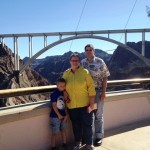
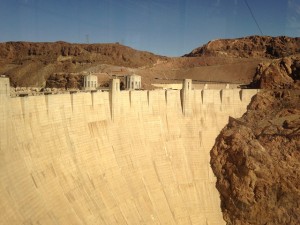
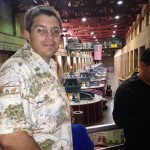
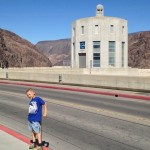

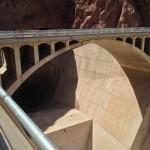
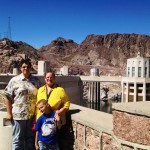
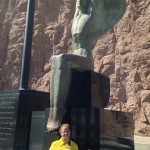

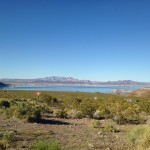
We visited Hoover Dam several years ago–that year we did Disneyland with John. I had no idea it cost so much. Wow!
That was the price for the tour, but if you park on the Arizona side and just walk along the dam that is free.
Wow, that’s a lot of energy going to California. Very interesting.